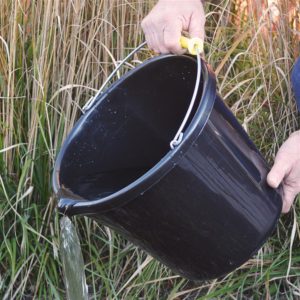
A casual visitor might view it much the same as they would the old camera collection or assortment of unusual stones which line display shelves in my office. Little would they know that the brass carbide mining lamp sitting among the other collectibles was a virtual lifeline for my grandfather, Owen Jones, as he toiled for many years deep in the mines of the Midwest.
Even today, with batteries and electricity and miniature diodes which burn brighter and longer than any monofilament bulb could ever hope to, the carbide lamp or lantern still holds a place in lighting the world. The lamps and lanterns are still a very dependable, consistent bright-burning source of non-electric illumination.
All carbide lamps and lanterns burn acetylene gas (C2H2) which is created on the spot inside the lantern by mixing calcium carbide and water. The calcium carbide is purchased in rock form and any water source will work. The lamps are amazingly simple pieces of technology that use multiple ingredients to (first) make a combustible fuel, and (second) then burn it fairly efficiently with little mess.
My introduction to carbide lamps came when my grandfather passed away when I was 12 years old. As my mom and her siblings struggled to sort out grandpa’s belongings they wanted to find a keepsake treasure for every child and grandchild. For some reason they chose to give me his mining lantern … and I am grateful. For the past 35 years the lamp has been a source of amusement, amazement, research, and, on occasion, a light.
While grandpa’s little lamp was used for lighting dark mine shafts deep underground, carbide lamps and lanterns have been put into service since the mid-1890s as lighthouse beacons, street lights, wagon and automobile headlights, bicycle lights, ship lamps, and to illuminate rooms and carry as hand lanterns.
Starting in the mid-1900s the battery-powered headlamp offered miners, cavers, coon hunters and fish and frog giggers a brighter light. But the time frame for that light was limited to the charge in the batteries. Carbide lamp users could work or enjoy their hobby way into the night as long as they had a tin of carbide and a source of water.
But enough of the sales tactics of why a carbide lamp is a good option. Let’s take a look at how they work. Today calcium carbide can purchased in cans, usually sold by the pound. It can be purchased in a store, through a catalog or online. When ordering online due to some added cost when shipping, it is usually sold in bulk quantities of several 2-pound cans totaling 10 pounds or more. Thomas Wilson is credited with coming up with an efficient process for making calcium  carbide, which he quickly patented and sold to Union Carbide in 1895.
carbide, which he quickly patented and sold to Union Carbide in 1895.
Carbide lamps and lanterns have two chambers, an upper chamber for water and a lower chamber – sometimes call a generator – which holds the calcium carbide granules. Some form of adjustable valve joins the two and is used to meter the amount of water allowed to drip into the lower chamber onto the calcium carbide. When the water meets the granules a chemical reaction occurs creating acetylene gas. More water equals more gas and a larger and brighter flame. The process of producing the gas generates a small amount of heat in the generator chamber, known as “exothermic†heat. For miners working in cold, damp caves this residual heat was often used to warm hands and help stave off dangerous hypothermia. If setting a lamp or lantern on a good piece of furniture it might pay to use a trivet or hot pad just to protect the furniture’s finish.
Once the water and granules produce acetylene, the gas passes through a vent tube and exits the lamp at the point of ignition. Most lamps come with a built-in flint striker to ignite the flame. But matches or any other form of simple lighter will work equally well.
Most carbide lanterns have some kind of metal reflector which helps multiple and focus the light generated. Carbide lamps usually have a glass globe. The one drawback to acetylene is that when it burns it produces a sooty flame. Cleaning the reflector or globe periodically is a must to keep your lantern or lamp working at the peak efficiency. Anyone who has ever ventured into a cave has likely seen black markings and sometimes even graffiti created purposefully by the soot of an acetylene flame from someone who ventured into the abyss at some earlier time. Low overhead clearances in caves are often coated by the sooty remnants of countless carbide lamps passing close by.
An interesting side note here is that mining lamps could be made of nearly any type of metal, but many were made from brass. These brass, non-ferromagnetic lamps were commonly used by cave surveyors who could rely on the bright light of the lamp to illuminate the face of a magnetic compass without the metal in the lamp itself resulting in a false reading.
As a little boy I took my grandpa’s lamp home and gave it a thorough cleaning. Grandpa had been disabled for several years at the time of his passing, and his little lamp had spent many years sitting on a shelf in the shed collecting dust. I had to carefully chisel the white residue from the inside of the generator chamber, and open up the passage between the water chamber and generator, and the tiny hole in the nozzle where the gas exits at the center of the reflector.
Next I found a source for carbide. My local hardware store carried small cans produced by Union Carbide. You can imagine my amazement the first time I put a few of the calcium carbide granules in the lamp’s lower chamber and trickled water into the upper reservoir from the outside hydrant. I slowly thumbed the drip control lever open and held the lantern cupped in my hands, feeling the heat start to rise inside as the chemical reaction produced a canister of flammable gas. With the flick of the flint lighter an inch-long flame appeared at the front of my lamp. I remember my thoughts turned to all the strange and unusual things my grandpa must have seen using that lamp in caverns beneath the surface.
That lamp holds a prominent place on a shelf in my office. My original can of calcium carbide is stored on a shelf in my garage. Ever so often someone asks how it works, or I just get an itch to see it burn and think about Grandpa Jones, and I dump in a few granules and a small amount of water and wait to feel the lamp warming up. There are few guarantees in life, but if you have a lamp or lantern, calcium carbide and water you can rest assured you can always have light.

































Nice article. I have and old one of these myself which was my grandfathers….good to read about it.
I have one that was my Grandfather’s and he used it to coon hunt at night.
Thanks for that bit of history. My Grandfather was also a miner and had one of these.
I too, have an old carbide miners lamp. I believe it may have been my Great Uncle’s. I also have another old carbide lamp, that for as long as I can remember, was told it was an old railroad signal man’s light. Recently I found out it is actually a bicycle lamp that someone along the line fashioned a wrought iron handle for. Neat stuff!
My father-in-law recently told us that his Grandparents had a carbide lighting system in their home — even after electricity came into the area, they didn’t switch over until sometime later on. My father wasa deep coal miner and had one of these carbide lights on his helmet — they really are bright good light.
[…] View article: Carbide Lamps: A real piece of history | Lehman's Country Life […]